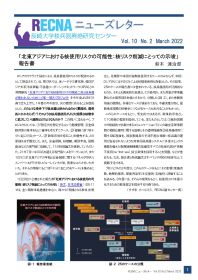新着情報What’s New
REC-PP-15
これからの軍縮教育:日韓の視点から(2022年3月)
中村 桂子, 李 起豪
[全文閲覧] ※引用元:http://hdl.handle.net/10069/00042186
本ポリシーペーパーは、2021年12月18日に行われた同タイトルの核兵器廃絶市民講座(主催:核兵器廃絶長崎連絡協議会、共催:長崎大学核兵器廃絶研究センター)の講演を基に、内容を大幅に拡充して講師2人(中村桂子、李起豪)が執筆したものである。
本文中にもあるように、李教授はこれまで多くの学生とともに長崎を訪問し、両国の若者が胸襟を開いて話し合う数々の素晴らしい機会を提供してくれた。なかでも、脱北者の若者と、韓国の大学生、そして長崎の大学生が一堂に会し、それぞれの文化の違いや平和についての想いを真摯に語り合った時のことは忘れられない。
李教授とは繰り返し、「お互いに学びあう」ことの重要性を話し合ってきた。日本と韓国の若者を取り巻く環境はけっして穏やかなものではない。安全保障をめぐる厳しい現実と、根深い両国の政治的対立は、若者たちの心にも暗い影を落としている。しかし希望はあると考える。私たちの取り組みは極めて小さい規模ではあったが、それでも「知る」ことから始まる交流は、学生たちの考えや姿勢に大きな変化をもたらしたことが見てとれたからだ。
ちょうどこのペーパーをまとめている時、ロシアのウクライナ侵攻が始まった。世界はますます混迷を極め、人々は先の見えない恐怖と不安に包まれている。核使用の恫喝を行う大国の姿を前に、日本においても、自国の安全を守るためとして核兵器依存の強化を求める声が上がっている。
この状況を前に、教育の重要性を説くことは極めて迂遠な提案のように受け取られるかもしれない。しかしむしろこのような時代だからこそ、軍縮教育が本来持つ力を発揮させなければならないと考える。それは第1章で述べているように、「変革に向けて一人ひとりが力をつけていく」ことがこの時代において何よりも求められているからである。
軍縮教育という領域は、その大きな意義に反して、学術研究の対象としても、また体系的な実践においても、未だ発展途上にある。今後取り組んでいくべき課題は大きい。本ペーパーがその発展に少しでも資することができれば幸いある。
是非ご覧ください。
[全文閲覧] ※引用元:http://hdl.handle.net/10069/00042186
★ 既刊のレクナポリシーペーパーは こちら
「緊急討論:ウクライナ危機Ⅱ」(3月25日 16:00-18:00)
※ 当日の動画を公開しました。YouTube でご覧いただけます。
※ レジュメ(4月5日改訂版)は、こちら でご覧いただけます。
ロシアのウクライナ侵攻は、多くの犠牲者と難民、破壊をもたらしています。核大国ロシアのプーチン大統領は、核兵器の警戒態勢を高めるなど、核兵器の使用を示唆する動きも示してきました。ウクライナ内にある原発をロシア軍が占拠する事態も相次いでいます。「国際人道法」の視点から眺めた場合、この戦争のどんな問題がくっきりと見えてくるのでしょうか。
長崎大学核兵器廃絶研究センター(RECNA)と同多文化社会学部、同グローバル巨大リスク研究プロジェクト(NURECSA)の共催で、緊急討論会を開催することにしました。国際人道法がご専門の真山全・大阪大学教授に話題提供をしていただき、その後、長崎大学の教授陣との間でパネル討論を行います。ウクライナ危機について多面的に考えるとともに、解決に向けて被爆地長崎の役割も考えます。
| 日 時: | 2022年3月25日(金)16:00~18:00 |
| 開催方法: | Zoomウェビナーによるオンライン配信 |
| 登 壇 者: |
【話題提供】 真山 全 大阪大学大学院国際公共政策研究科教授 「この戦争の問題点――国際人道法(武力紛争法)の視点から」 【パネル討論】 *登壇者のプロフィールは こちら(PDF) |
| 共 催: | 長崎大学核兵器廃絶研究センター(RECNA) 長崎大学多文化社会学部 グローバル巨大リスク研究プロジェクト(NURESCA) |
お問い合わせ:RECNA事務室
Tel:095-819-2164
e-mail:recna_staff@ml.nagasaki-u.ac.jp
REC-PP-14
「人道的軍縮」と市民社会:韓国の対人地雷対策の検証(2022年3月)
目加田 説子
「軍縮」という言葉は、特定の兵器の規制や削減、禁止、廃棄などを意味する。すなわち、「軍縮」の具体的な対象は基本的には武器であったり、武器に関する措置であったりする。したがって、個々の「軍縮」条約は、対象となる武器の名称・範疇や、武器に関する規制措置を冠するのが通例だ。生物兵器禁止条約(1972 年発効)、特定通常兵器使用禁止制限条約(1983 年発効)、化学兵器禁止条約(1997 年発効)などである。
それでは、「人道的軍縮」は、「軍縮」とどのような共通点・相違点があるのだろうか。人道的軍縮は比較的新しい概念であり、その定義についてまだ確立されたものが存在するわけではないが、次のような点を指摘できるだろう。まず共通点だが、特定の兵器の規制や削減、禁止、廃棄など、従来の「軍縮」が内包しているアジェンダが「人道的軍縮」にも含まれているところである。だが、重要なことは、むしろ相違点にある。
「人道的軍縮」の場合には、(1)従来の軍縮アプローチとは対照的に、国家の安全保障だけでなく、人々の安全と福祉を守ることを重視する、(2)特に兵器がもたらす「人的・環境的影響」を軽減することで民間人の保護を強化することを目指す、といった点が特徴的である。「軍縮」という言葉を広義に解釈し、さらには人道主義に高い優先順位をつけることによって、特定の兵器の削減や制限・禁止に留まらず、兵器に関わる問題全般への対処に必要なさまざまな措置を包含している。「人道的軍縮」に基づく条約が、武器に関する条文だけでなく、人道的観点から被害者の救済を条文に盛り込んでいるのは、そうした理念に基づいている。
対人地雷禁止条約(1999 年発効)、クラスター爆弾禁止条約(2008 年発効)などの成功例によって次第に広まってきた「人道的軍縮」は、今や最大級の非人道兵器の廃絶をめざす核兵器禁止条約(2021 年発効)へと進化した。核兵器禁止条約も第7条で、核爆発実験を実施した国に対し、被害者に対する援助について規定している。
このような歴史的潮流の中で、「人道的軍縮」としての核兵器禁止条約を運用していくにあたり、先行の条約から得るべき教訓は何なのだろうか。もちろん、核兵器は他の兵器とは異なる非人道的な属性を有しているのは論を俟たないが、人道主義をどのように政策に実装し、非人道的な被害に向き合っていくかという点では、先例が参考になる面も少なくないだろう。以上のような視点から、この論考では、対人地雷禁止条約の締約国ではないにもかかわらず、同条約の規範力を活用しながら、地雷除去や被害者救済を進めてきた韓国の事例に焦点をあて、「人道的軍縮」に欠かせない要素を考えてみたい。
是非ご覧ください。
★ 既刊のレクナポリシーペーパーは こちら
「緊急討論:ウクライナ危機Ⅰ」(3月16日 10:00-12:00)
※下斗米先生の講演資料を公開しました。【(PDF)】
2022年2月24日に始まった、ロシアのウクライナ侵攻は、すでに多くの犠牲者と破壊を生んでいます。核大国ロシアのプーチン大統領は、核兵器の警戒態勢を高めるなど、核兵器の使用を示唆する動きまで示しています。冷戦終了後、築き上げてきた国際秩序を大きく揺るがすこの戦争を、どうとらえればいいのでしょうか。
長崎大学核兵器廃絶研究センター(RECNA)と同多文化社会学部、グローバル巨大リスク研究プロジェクト(NURESCA)の共催で、緊急討論会を開催することになりました。外部からはソ連・ロシア政治史の第一人者である下斗米伸夫法政大学名誉教授に話題提供をしていただき、その後長崎大学の教授陣との間で、パネル討論を行います。ウクライナ危機について、少しでも理解を深め、解決に向けて被爆地長崎の役割を考えます。皆様のご参加をお待ちしております。
| 日 時: | 2022年3月16日(水)10:00~12:00 |
| 開催方法: | Zoomウェビナーによるオンライン配信 |
| 登 壇 者: |
【話題提供】 下斗米伸夫 法政大学名誉教授、神奈川大学特別招聘教授 「ウクライナ戦争考―挫折したミンスクⅢ」 *講演資料はこちら(PDF) 【パネル討論】 *登壇者のプロフィールはこちら(PDF) |
| 共 催: | 長崎大学核兵器廃絶研究センター(RECNA)、長崎大学多文化社会学部、グローバル巨大リスク研究プロジェクト(NURESCA) |
(※お申込み受付は終了いたしました。)
※要事前申込 こちらよりお申込みください。【申込締切:3月15日(火)正午まで】

















